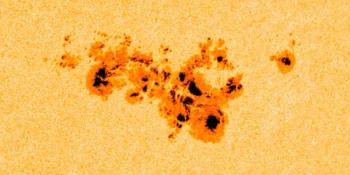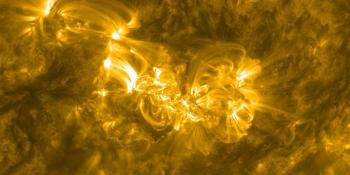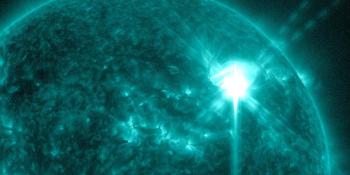Vaata reede, 17 veebruar 2012 arhiivi
Päikese aktiivsuse aruanne
Any mentioned solar flare in this report has a scaling factor applied by the Space Weather Prediction Center (SWPC). Because of the SWPC scaling factor, solar flares are reported as 42% smaller than for the science quality data. The scaling factor has been removed from our archived solar flare data to reflect the true physical units.
Päikese ja geofüüsikalise aktiivsuse aruanne 2012 Feb 17 2200 UTCValminud NOAA © SWPC ja töödeldud SpaceWeatherLive.com-iga
Ühine USAF / NOAA päikese- ja geofüüsikaalase aktiivsuse aruanne
SDF number 048 Välja antud 2200Z kuni 17 Feb 2012IA. Päikese aktiivsete piirkondade ja päikeseaktiivsuse analüüs alates 16-2100Z kuni 17-2100Z Solar activity was at very low levels. Region 1418
(S23W55) redeveloped spots as a B-type group. The remaining regions
were quiet and stable. Two filament eruptions were observed during
the period. The first eruption was a 9 degree long filament
centered near N26E41 that lifted off at about 17/0130Z. The second
eruption was a 16 degree long filament centered near S33W17 that
lifted off at about 17/0553Z. LASCO C2 imagery observed a very
faint, slow-moving CME off the SSE limb first visible about
17/0745Z. This CME does not appear to have an Earth-directed
component.
IB. Päikese aktiivsuse ennustus
Solar activity is expected to be very
low with a chance for C-class activity for the next three days (18 -
20 February).
IIA. Summaarne geofüüsikaline aktiivsus 16-2100Z kuni 17-2100Z
The geomagnetic field was at quiet levels. ACE solar wind velocities
decreased during the period from about 350 km/s to near 300 km/s
while the Bz component of the interplanetary magnetic field did not
vary much beyond +/- 4 nT.
IIB. Geofüüsikalise aktiivsuse ennustus
The geomagnetic field is
expected to be at mostly quiet levels through most of day one (18
February). By late on day one and through day two (19 February),
field activity is expected to increase to quiet to unsettled levels,
with isolated active periods, due to recurrent coronal hole high
speed stream effects. A return to mostly quiet conditions is
expected by day three (20 February).
III. Sündmuste tõenäosus 18 Febkuni 20 Feb
| Klass M | 01% | 01% | 01% |
| Klass X | 01% | 01% | 01% |
| Prooton | 01% | 01% | 01% |
| PCAF | green | ||
IV. Pikklaine 10.7 cm kiirgus
Vaadeldud 17 Feb 104 Prognoositud 18 Feb-20 Feb 105/100/110 90 päeva keskmine 17 Feb 132
V. Geomagneetiline A-indeks
Vaadeldud Afr/Ap 16 Feb 004/003 Hinnanguline Afr/Ap 17 Feb 002/002 Prognoositud Afr/Ap 18 Feb-20 Feb 007/008-008/008-004/005
VI. Geomagnetilised aktiivsuse tõenäosused 18 Feb kuni 20 Feb
| A. Keskmistel laiuskraadidel | |||
|---|---|---|---|
| Aktiivne | 30% | 30% | 15% |
| Väike torm | 15% | 15% | 01% |
| Suur-tõsine torm | 01% | 01% | 01% |
| B. Kõrgetel laiuskraadidel | |||
|---|---|---|---|
| Aktiivne | 40% | 40% | 20% |
| Väike torm | 20% | 20% | 05% |
| Suur-tõsine torm | 05% | 05% | 01% |
<< Mine igapäevase ülevaate lehele
Viimane uudis
Viimane foorumi postitus
AR3664 636[CME] AR 13664, flare flurry, CMEs galore, 2024-05-08/09 164Unproven theories 399Is there any truth to this "Internet/Electrical Grid Apocalypse"? 93Weakening of Earths magnetic field due to geomagnetic excursion 19
Veel teemasidToeta SpaceWeatherLive.com-i!
Paljud inimesed külastavad SpaceWeatherLive lehte selleks, et jälgida, mis toimub Päikesel või, kas on oodata virmalisi. Suurema liiklusega on serveri koormus ning maksumus kõrgem. Kui sulle meeldib see, mida me sinu heaks teeme, siis saad sa sellele ka ise natukene kaasa aidata, annetades selle lehe käigus hoidmise ja arendamise heaks. Ette tänades SpeaceWeatherLive meeskond!

Fakte kosmose ilmast
| Viimane X-loide | 10/05/2024 | X3.8 |
| Viimane M-loide | 10/05/2024 | M1.3 |
| Viimane geomagnetiline torm | 06/05/2024 | Kp5 (G1) |
| Plekivabasid päevi | |
|---|---|
| Viimane päikese plekivaba päev | 08/06/2022 |
| Kuu keskmine päikeseplekkide arv | |
|---|---|
| aprill 2024 | 136.5 +31.6 |
| Viimased 30 päeva | 167.9 +77.8 |


